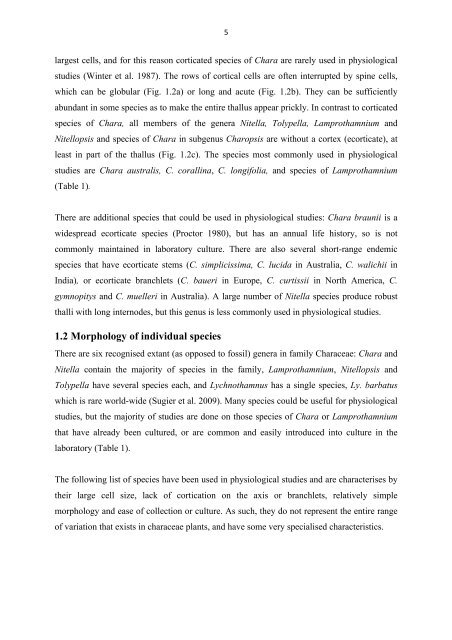Chapter 1: The Characeae Plant
Chapter 1: The Characeae Plant
Chapter 1: The Characeae Plant
You also want an ePaper? Increase the reach of your titles
YUMPU automatically turns print PDFs into web optimized ePapers that Google loves.
5 <br />
largest cells, and for this reason corticated species of Chara are rarely used in physiological<br />
studies (Winter et al. 1987). <strong>The</strong> rows of cortical cells are often interrupted by spine cells,<br />
which can be globular (Fig. 1.2a) or long and acute (Fig. 1.2b). <strong>The</strong>y can be sufficiently<br />
abundant in some species as to make the entire thallus appear prickly. In contrast to corticated<br />
species of Chara, all members of the genera Nitella, Tolypella, Lamprothamnium and<br />
Nitellopsis and species of Chara in subgenus Charopsis are without a cortex (ecorticate), at<br />
least in part of the thallus (Fig. 1.2c). <strong>The</strong> species most commonly used in physiological<br />
studies are Chara australis, C. corallina, C. longifolia, and species of Lamprothamnium<br />
(Table 1).<br />
<strong>The</strong>re are additional species that could be used in physiological studies: Chara braunii is a<br />
widespread ecorticate species (Proctor 1980), but has an annual life history, so is not<br />
commonly maintained in laboratory culture. <strong>The</strong>re are also several short-range endemic<br />
species that have ecorticate stems (C. simplicissima, C. lucida in Australia, C. walichii in<br />
India), or ecorticate branchlets (C. baueri in Europe, C. curtissii in North America, C.<br />
gymnopitys and C. muelleri in Australia). A large number of Nitella species produce robust<br />
thalli with long internodes, but this genus is less commonly used in physiological studies.<br />
1.2 Morphology of individual species<br />
<strong>The</strong>re are six recognised extant (as opposed to fossil) genera in family <strong>Characeae</strong>: Chara and<br />
Nitella contain the majority of species in the family, Lamprothamnium, Nitellopsis and<br />
Tolypella have several species each, and Lychnothamnus has a single species, Ly. barbatus<br />
which is rare world-wide (Sugier et al. 2009). Many species could be useful for physiological<br />
studies, but the majority of studies are done on those species of Chara or Lamprothamnium<br />
that have already been cultured, or are common and easily introduced into culture in the<br />
laboratory (Table 1).<br />
<strong>The</strong> following list of species have been used in physiological studies and are characterises by<br />
their large cell size, lack of cortication on the axis or branchlets, relatively simple<br />
morphology and ease of collection or culture. As such, they do not represent the entire range<br />
of variation that exists in characeae plants, and have some very specialised characteristics.
















